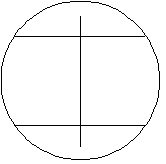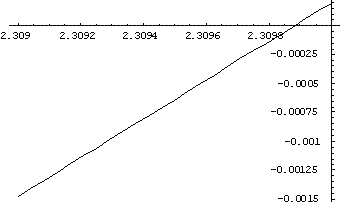Copyright © University of Cambridge. All rights reserved.
'Spokes' printed from https://nrich.maths.org/
Show menu
There are many ways to solve this problem. See the Hints for suggestions of other lines of investigation you might like to pursue to find other solutions.
Andrei from Tudor Vianu National College, Bucharest, Romania has come up with an unexpected arrangement of the sticks. Here is Andrei's solution:
|
I chose to make $2$ segments of the unit, each of area a
quarter of the unit circle, and the remained part of the circle to
be divided into two equal parts, as shown in the figure.
Let $x$ be the central angle determined by the segment. The
area of the segment is: $${1\over 2}\left(x - \sin x\right).$$ And
it must be a quarter the area of the circle so: $${1\over 2}\left(x
- \sin x\right)= {\pi \over 4} .$$
|
 |
This equation could be solved only numerically, and to find an
approximate solution I represent the function $x-\sin x - {\pi
\over 2}$ and I look for a change of sign.
 |
To find a better approximation I used this graph.
Plot $\left[x - \sin [x]- {\pi \over 2}, {x, 2.309,
2.31}\right]$
So $x \approx 2.3099$.
|